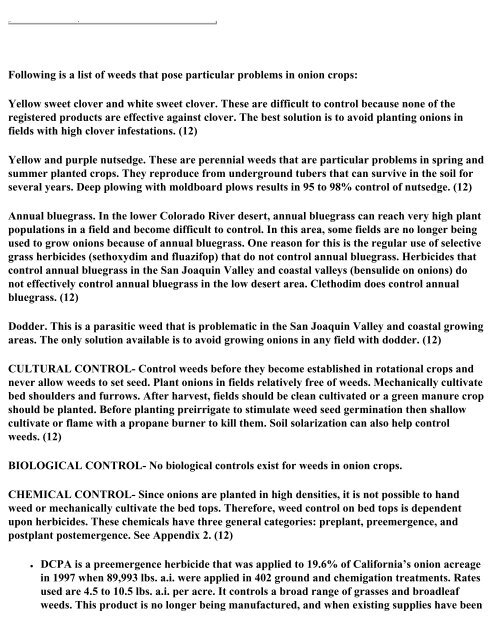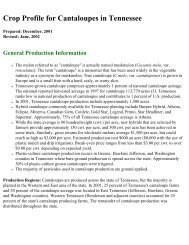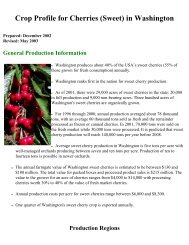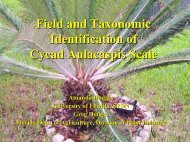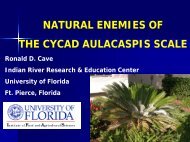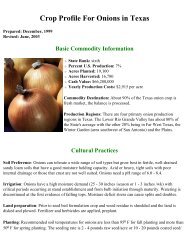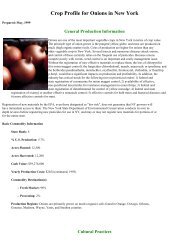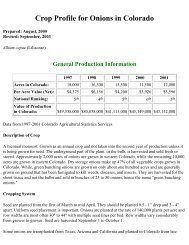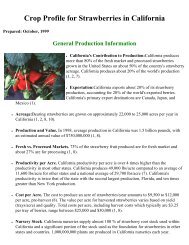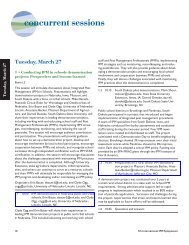Crop Profile for Onions in California - Regional IPM Centers
Crop Profile for Onions in California - Regional IPM Centers
Crop Profile for Onions in California - Regional IPM Centers
Create successful ePaper yourself
Turn your PDF publications into a flip-book with our unique Google optimized e-Paper software.
Follow<strong>in</strong>g is a list of weeds that pose particular problems <strong>in</strong> onion crops:<br />
Yellow sweet clover and white sweet clover. These are difficult to control because none of the<br />
registered products are effective aga<strong>in</strong>st clover. The best solution is to avoid plant<strong>in</strong>g onions <strong>in</strong><br />
fields with high clover <strong>in</strong>festations. (12)<br />
Yellow and purple nutsedge. These are perennial weeds that are particular problems <strong>in</strong> spr<strong>in</strong>g and<br />
summer planted crops. They reproduce from underground tubers that can survive <strong>in</strong> the soil <strong>for</strong><br />
several years. Deep plow<strong>in</strong>g with moldboard plows results <strong>in</strong> 95 to 98% control of nutsedge. (12)<br />
Annual bluegrass. In the lower Colorado River desert, annual bluegrass can reach very high plant<br />
populations <strong>in</strong> a field and become difficult to control. In this area, some fields are no longer be<strong>in</strong>g<br />
used to grow onions because of annual bluegrass. One reason <strong>for</strong> this is the regular use of selective<br />
grass herbicides (sethoxydim and fluazifop) that do not control annual bluegrass. Herbicides that<br />
control annual bluegrass <strong>in</strong> the San Joaqu<strong>in</strong> Valley and coastal valleys (bensulide on onions) do<br />
not effectively control annual bluegrass <strong>in</strong> the low desert area. Clethodim does control annual<br />
bluegrass. (12)<br />
Dodder. This is a parasitic weed that is problematic <strong>in</strong> the San Joaqu<strong>in</strong> Valley and coastal grow<strong>in</strong>g<br />
areas. The only solution available is to avoid grow<strong>in</strong>g onions <strong>in</strong> any field with dodder. (12)<br />
CULTURAL CONTROL- Control weeds be<strong>for</strong>e they become established <strong>in</strong> rotational crops and<br />
never allow weeds to set seed. Plant onions <strong>in</strong> fields relatively free of weeds. Mechanically cultivate<br />
bed shoulders and furrows. After harvest, fields should be clean cultivated or a green manure crop<br />
should be planted. Be<strong>for</strong>e plant<strong>in</strong>g preirrigate to stimulate weed seed germ<strong>in</strong>ation then shallow<br />
cultivate or flame with a propane burner to kill them. Soil solarization can also help control<br />
weeds. (12)<br />
BIOLOGICAL CONTROL- No biological controls exist <strong>for</strong> weeds <strong>in</strong> onion crops.<br />
CHEMICAL CONTROL- S<strong>in</strong>ce onions are planted <strong>in</strong> high densities, it is not possible to hand<br />
weed or mechanically cultivate the bed tops. There<strong>for</strong>e, weed control on bed tops is dependent<br />
upon herbicides. These chemicals have three general categories: preplant, preemergence, and<br />
postplant postemergence. See Appendix 2. (12)<br />
● DCPA is a preemergence herbicide that was applied to 19.6% of Cali<strong>for</strong>nia’s onion acreage<br />
<strong>in</strong> 1997 when 89,993 lbs. a.i. were applied <strong>in</strong> 402 ground and chemigation treatments. Rates<br />
used are 4.5 to 10.5 lbs. a.i. per acre. It controls a broad range of grasses and broadleaf<br />
weeds. This product is no longer be<strong>in</strong>g manufactured, and when exist<strong>in</strong>g supplies have been


